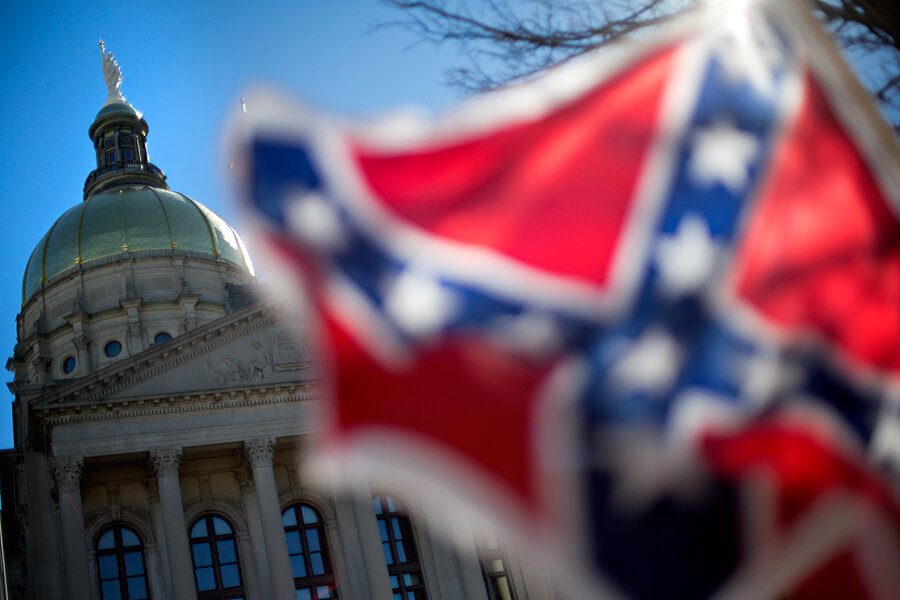Confederate flag: Washington and Lee University removing display
Loading...
Reproductions of the Confederate flag will no longer adorn Washington and Lee University’s campus in Lexington, Va., the university president announced Tuesday. However, the school will display historic rebel flags in the university’s Lee Chapel Museum.
The move came in response to a request from a group of W&L law-school students known as the Committee, which appealed to the university in the spring to remove the flags, to declare Martin Luther King Day a university holiday, and to take steps to confront the school’s murky history in conjunction with slavery.
The Committee members took particular umbrage at the presence of the flags in the part of the chapel where students take an honor oath.
“I am happy that we made some progress,” Committee member Brandon Hicks told The Roanoke Times. “Some of our concerns were met and some of them were not. We are happy with the removal of the Confederate flags from Lee Chapel and are in agreement with the placement of flags in the museum. That met our demands and is not an area where students have to convene.”
The rebel flags have been on display in Lee Chapel since 1930, when several original, historic flags belonging to the Museum of the Confederacy – now part of the American Civil War Museum in Richmond – were placed near a statue of Confederate Gen. Robert E. Lee, who served as the university president from 1865 to 1870. In the 1990s, the American Civil War Museum reclaimed the original flags to ensure their preservation, and the university hanged the reproductions in their stead, W&L President Kenneth Ruscio explained in an e-mail to faculty and students outlining his response to the concerns raised by the Committee.
“The purpose of historic flags in a university setting is to educate,” Mr. Ruscio wrote in an e-mail to faculty and students. “They are not to be displayed for decoration, which would diminish their significance, or for glorification, or to make a statement about past conflicts.”
Ruscio said that the decision to cancel classes on Martin Luther King Day lies with the faculty, but added that he would prefer to see classes continue with a focus on King's legacy, rather than adding another holiday to the school calendar.
"Canceling classes may have symbolic significance; I prefer the substance of our current programs over the symbolism of a day off," he wrote.
The university, he added, will continue to study its history with slavery, but he refused to admonish Lee, one of the school's namesakes.
"Robert E. Lee displayed his estimable skill as an innovative and inspiring educator," Ruscio wrote. "I personally take pride in his significant accomplishments here and will not apologize for the crucial role he played in shaping this institution."
Ruscio did acknowledge that the school had owned between 70 and 80 slaves during "a regrettable chapter" of the school's history and pledged "to continue to study [the school's] historic involvement with slavery."
The Confederate battle flag dates back to the Civil War when rebel troops carried the red banner emblazoned with a blue St. Andrew's cross into battles against Union troops. Until World War II, the flag was reserved for memorial ceremonies, but in the 1940s, the banner began to appear at cultural events in the US South. In the 1950s and ’60s, several Southern states incorporated the design into their state flags in protest of federally enforced school integration.
Starting in the 1990s, the American Civil Liberties Union launched protests aimed at swaying states to abandon the Confederate flag. Today, Mississippi is the only state that still uses the emblem in its flag.
Many Americans find the Confederate flag to be an offensive symbol of racism and hate. However, many Southerners maintain that the flag represents their cultural heritage and the memory of their ancestors. An embittered debate over the use of the flag has persisted for decades. Recently, the state of Georgia came under fire from the NAACP and other civil rights groups for offering a special license plate featuring the rebel flag in honor of the heritage group the Sons of Confederate Veterans.
[Editor's note: The original version of this story was incorrect in using another proper name interchangeably with the Confederate flag.]






